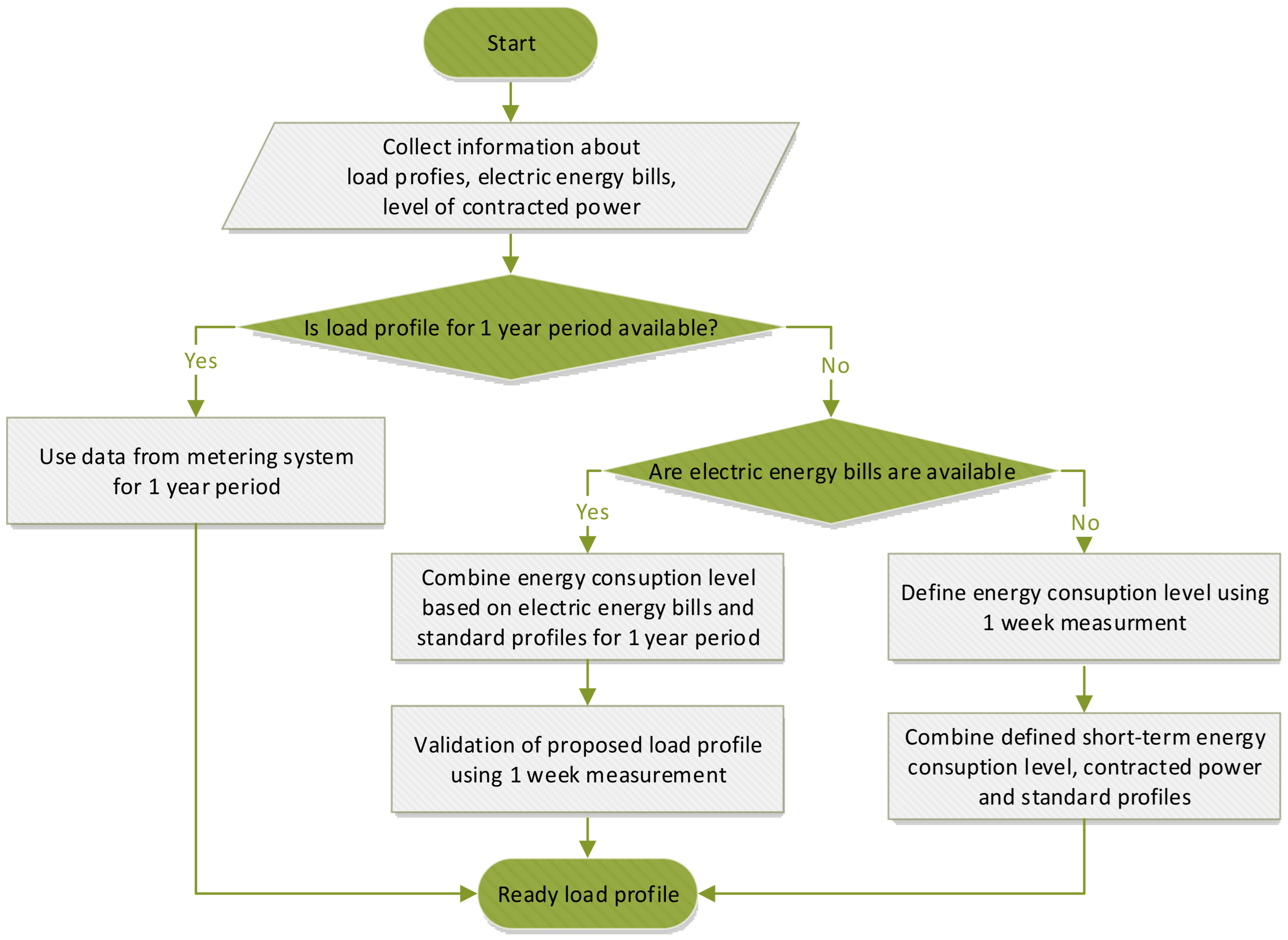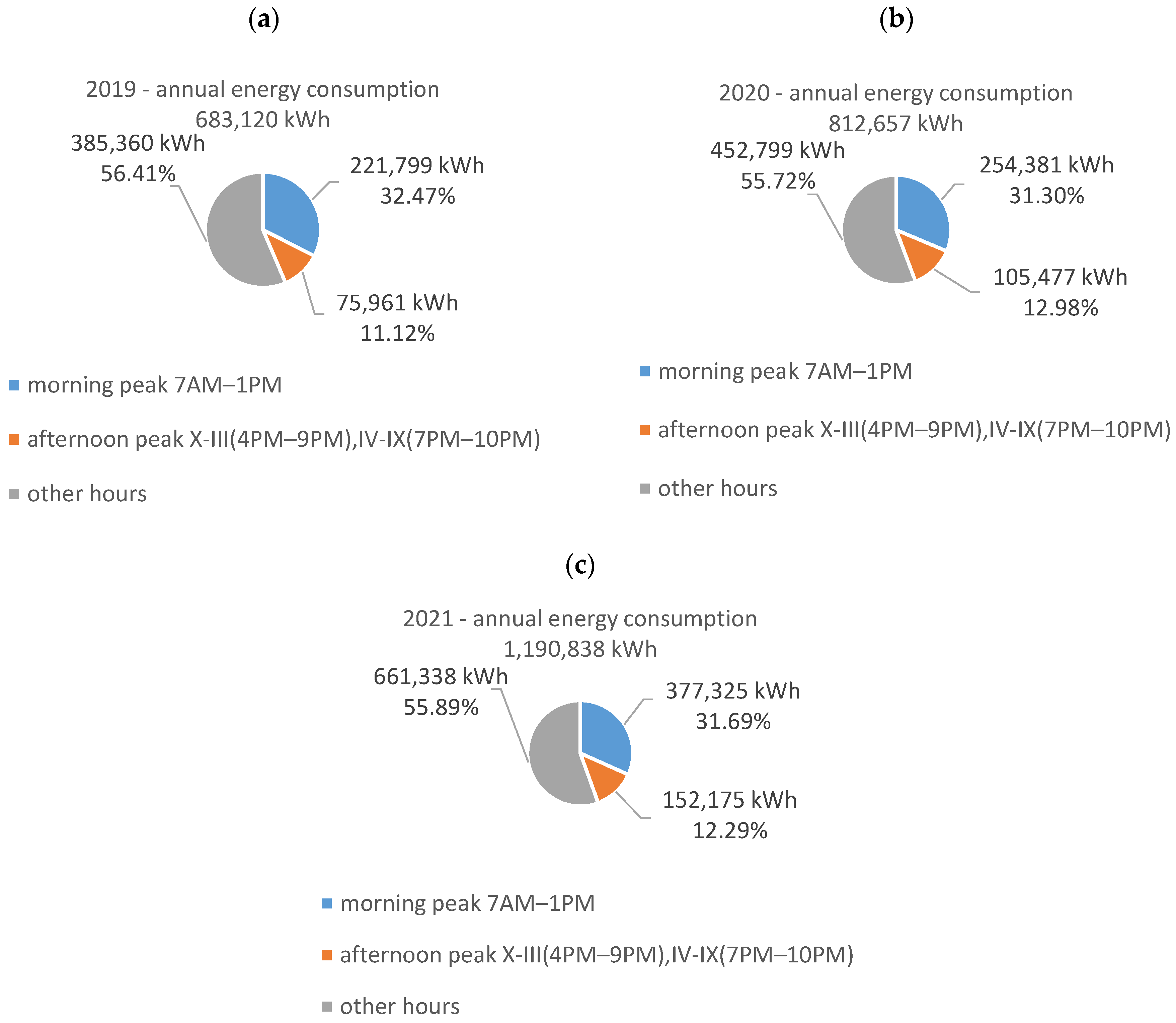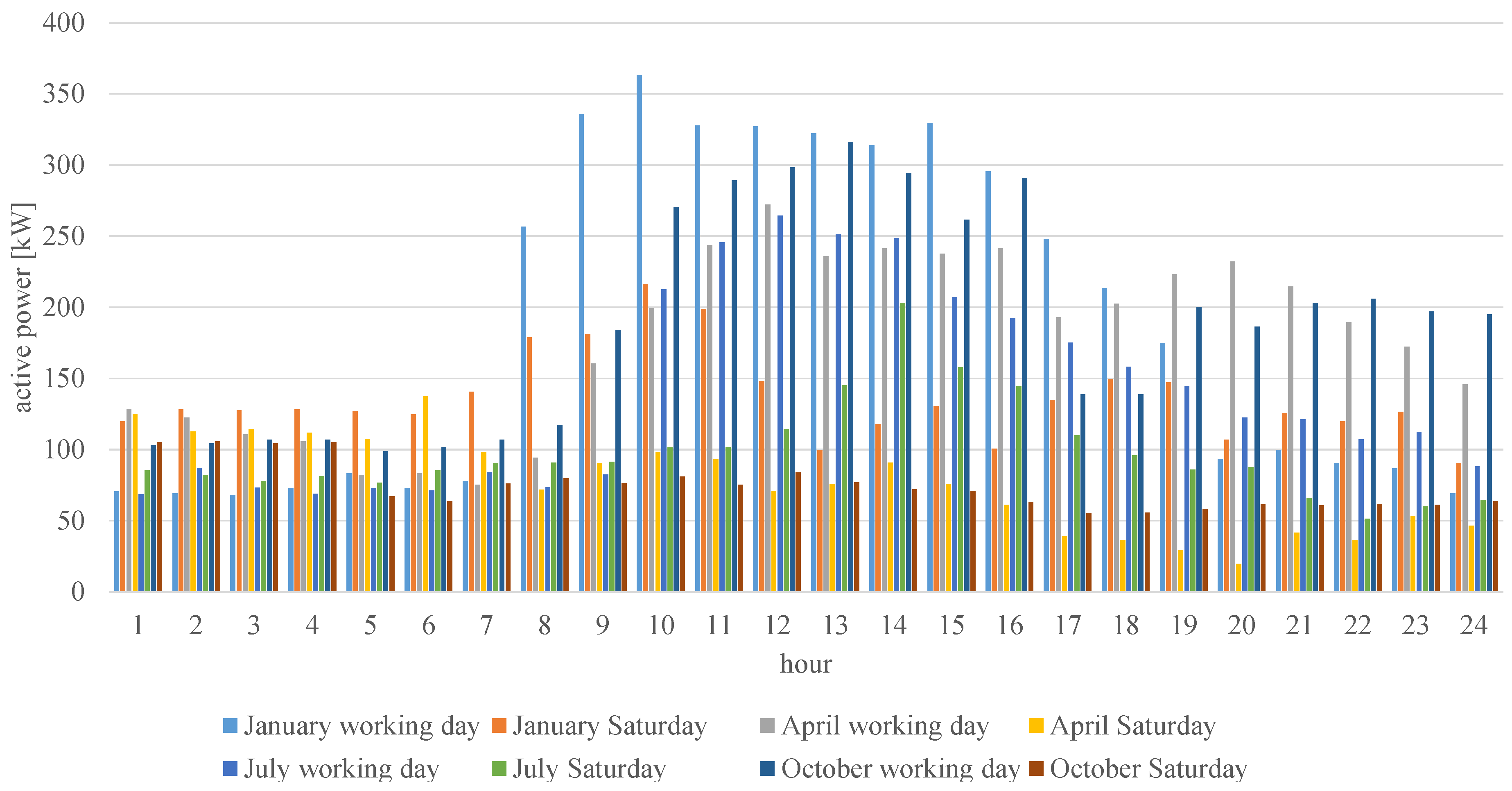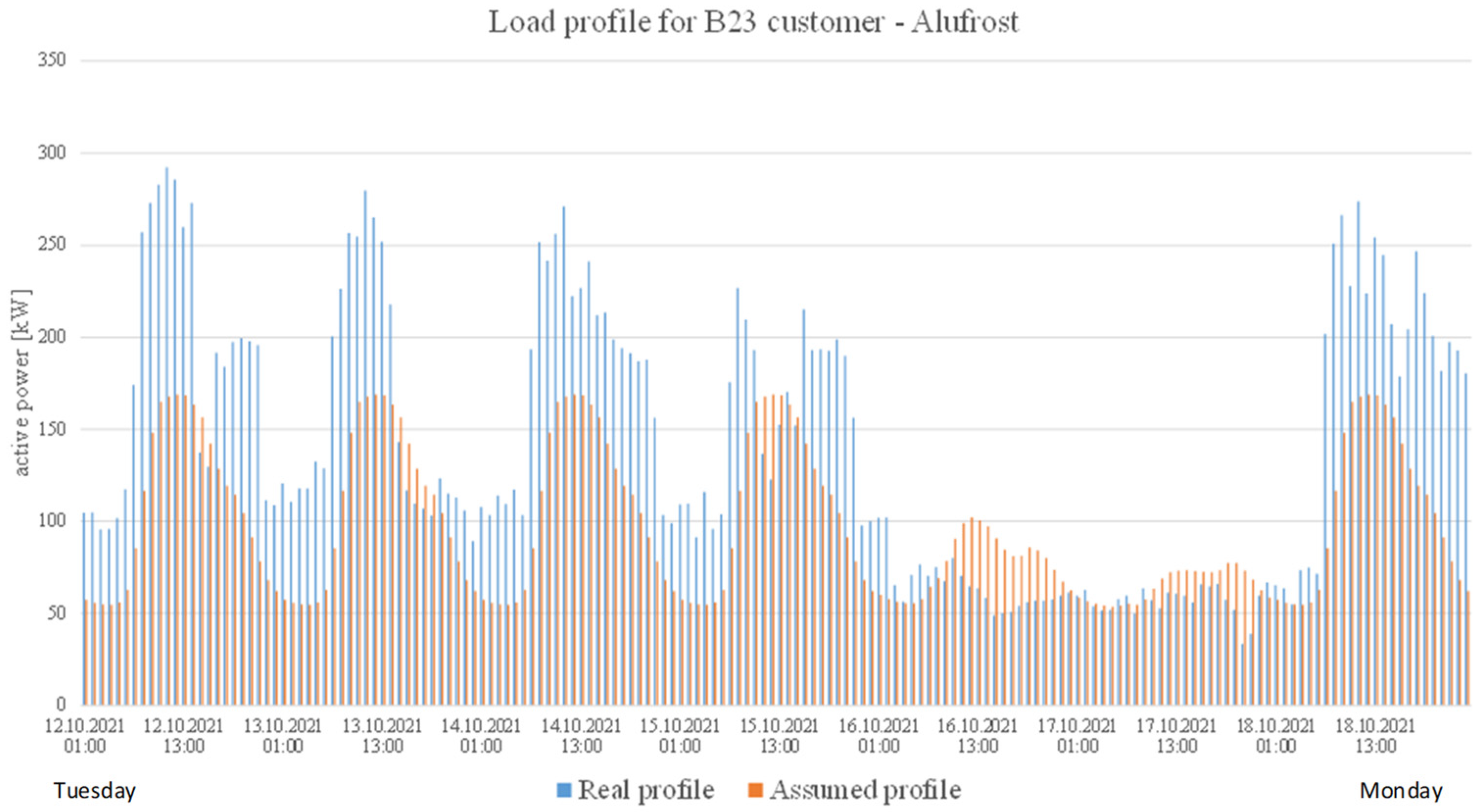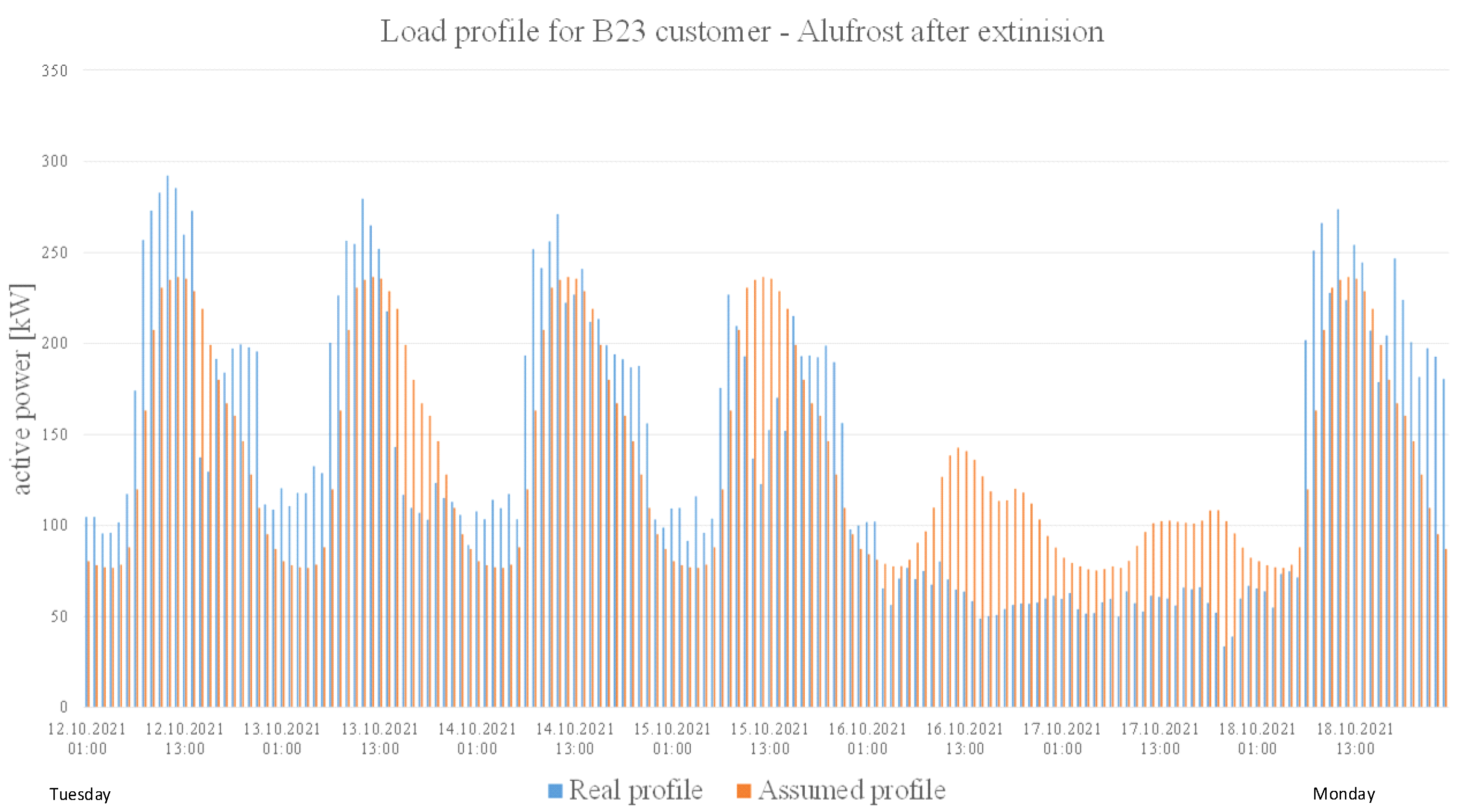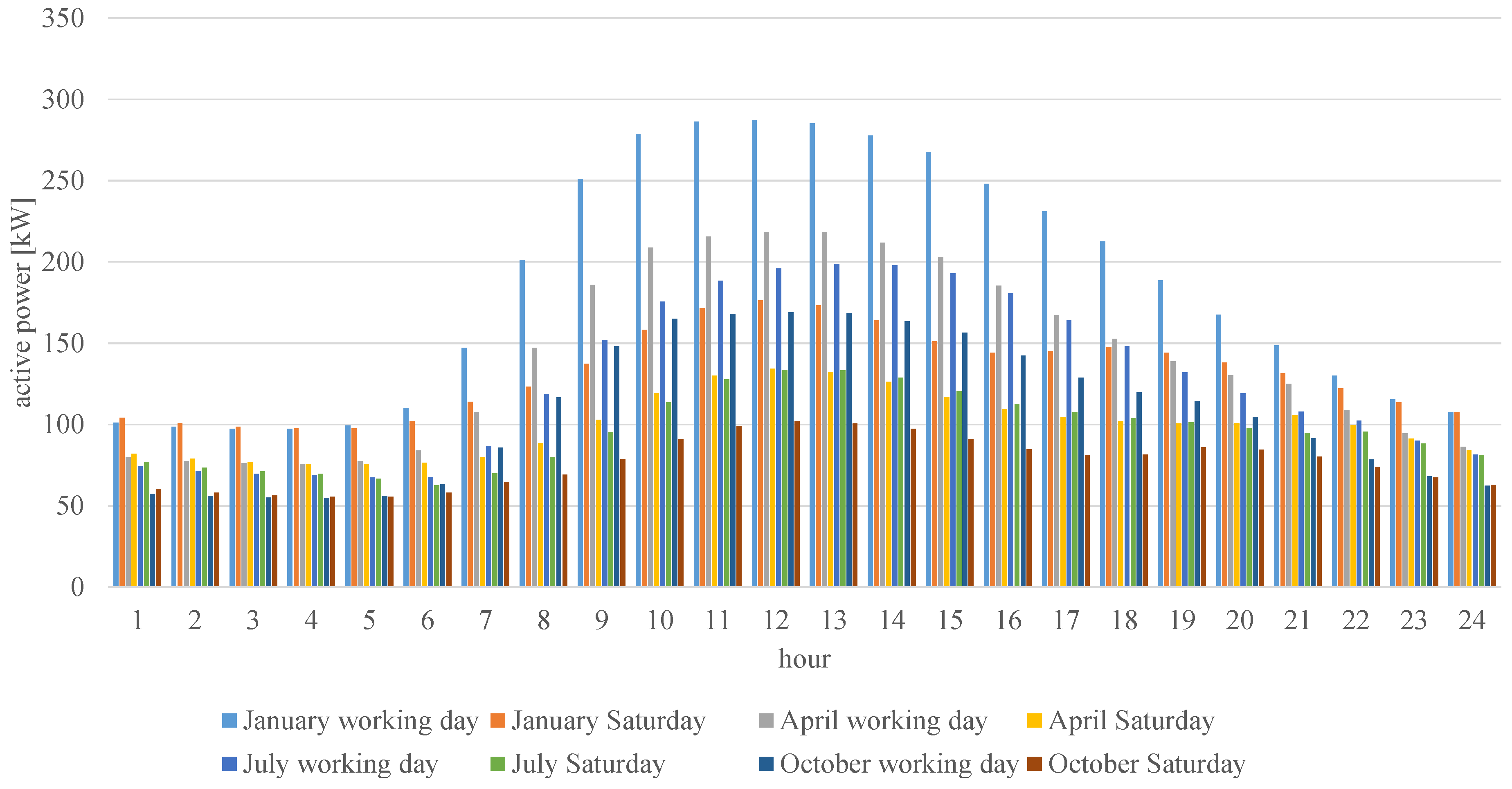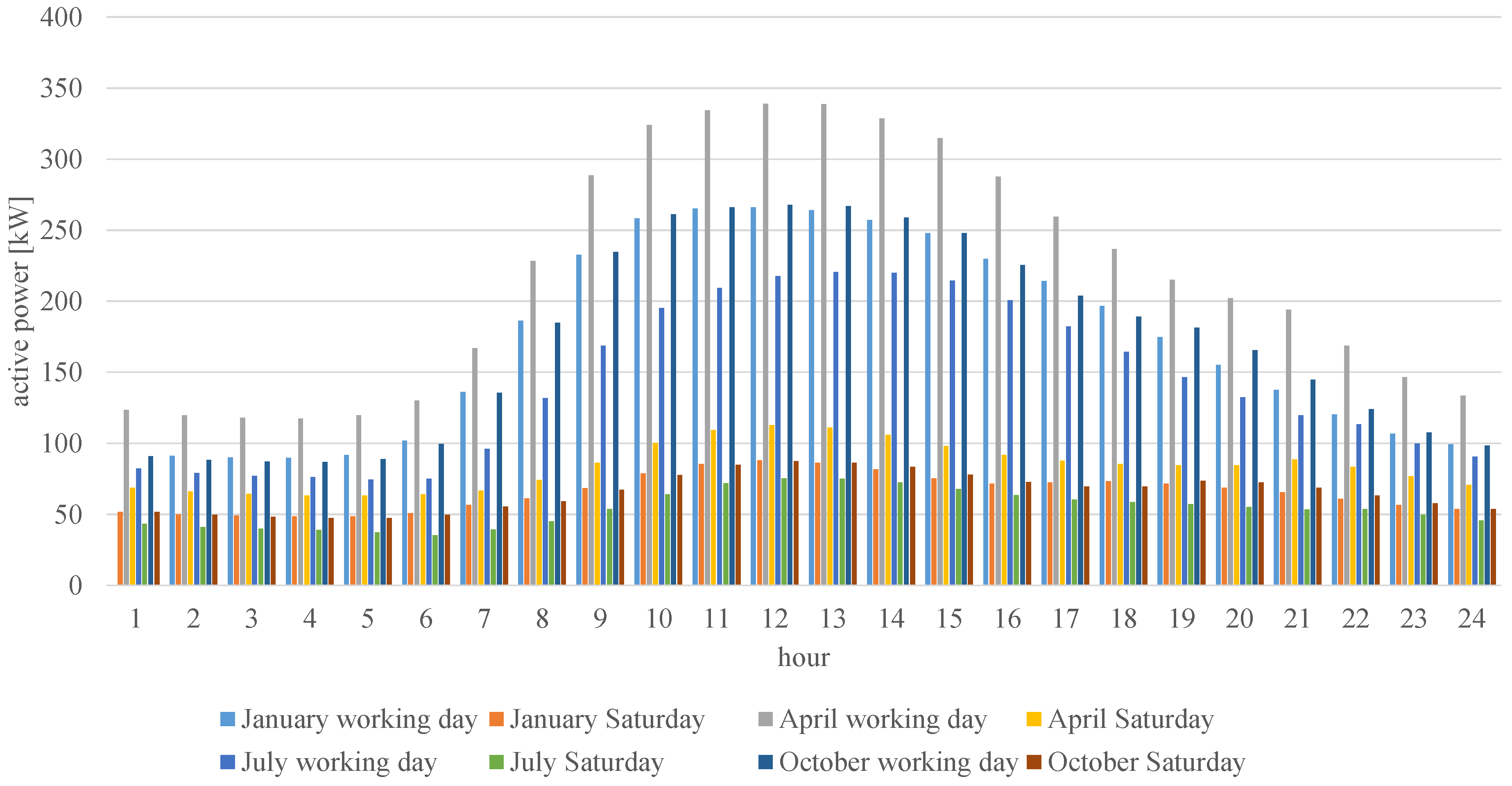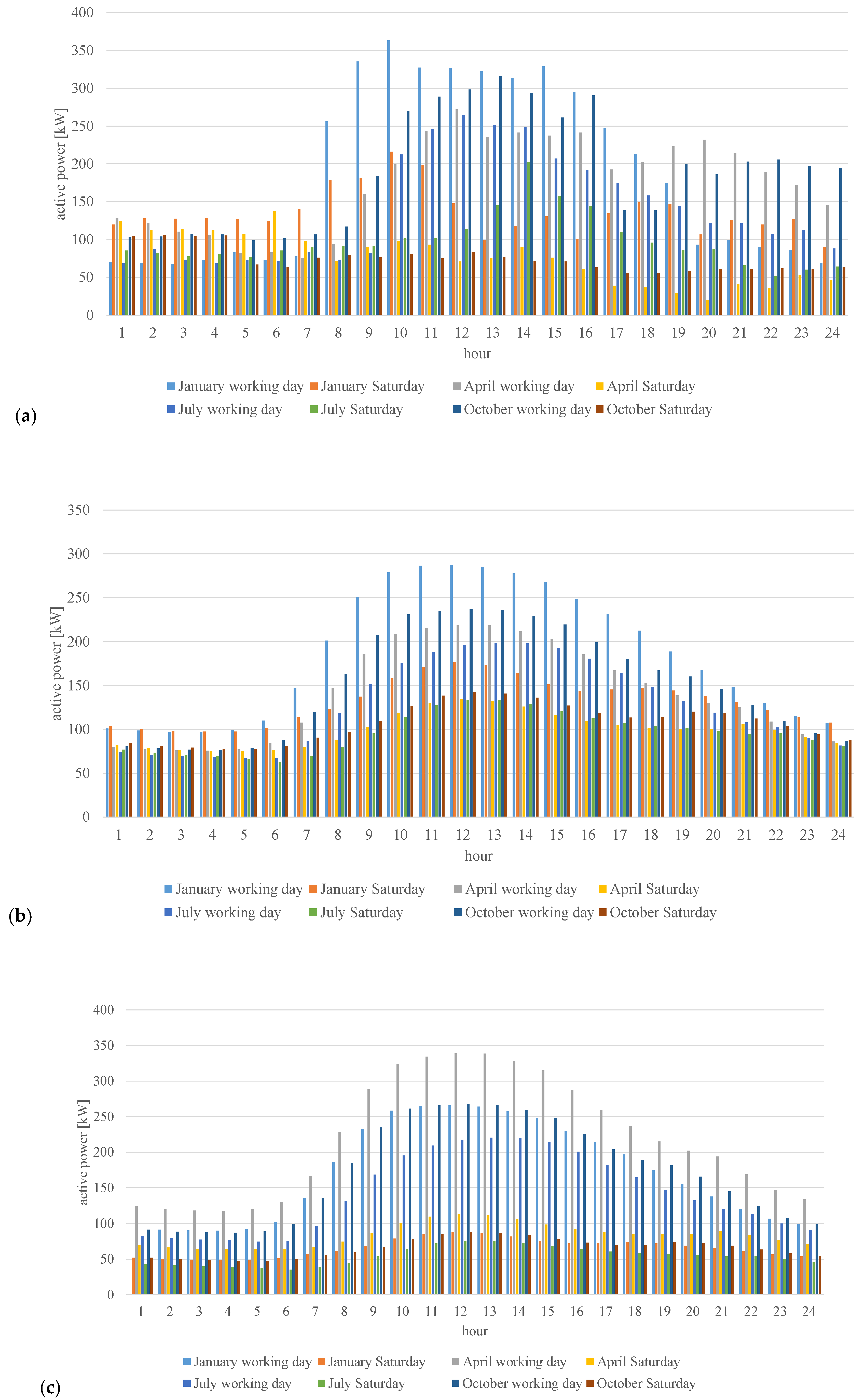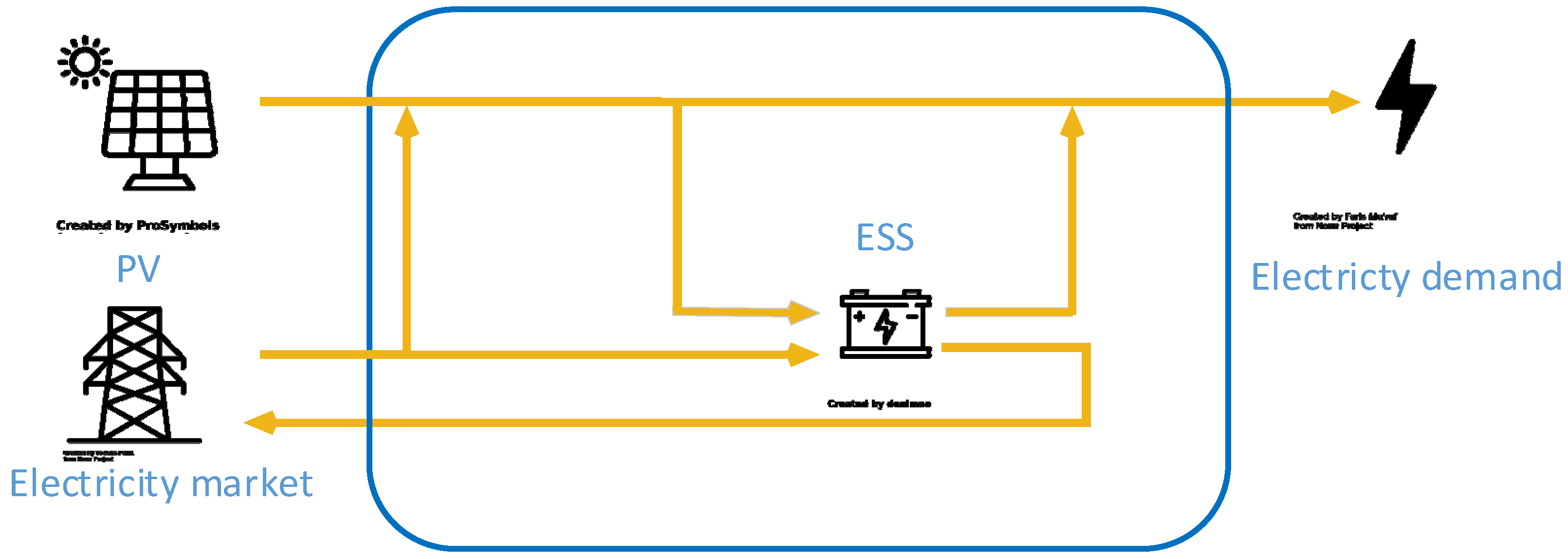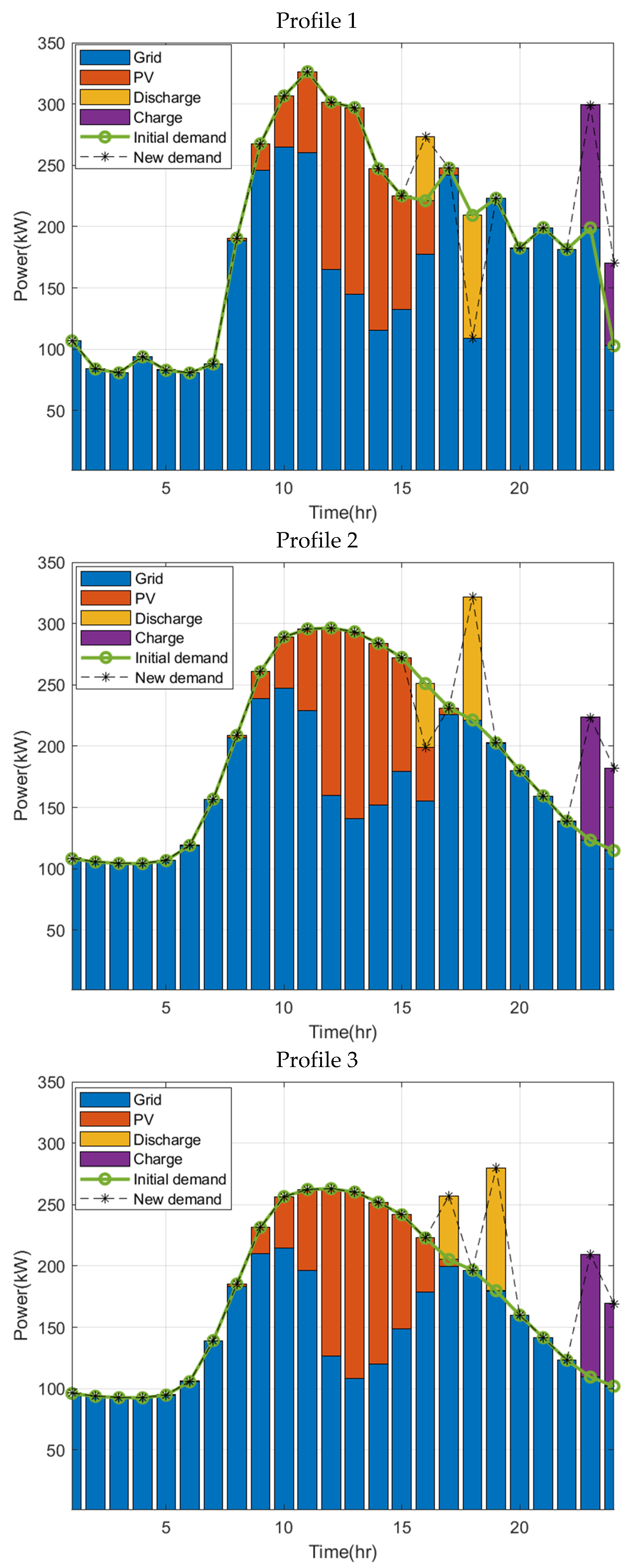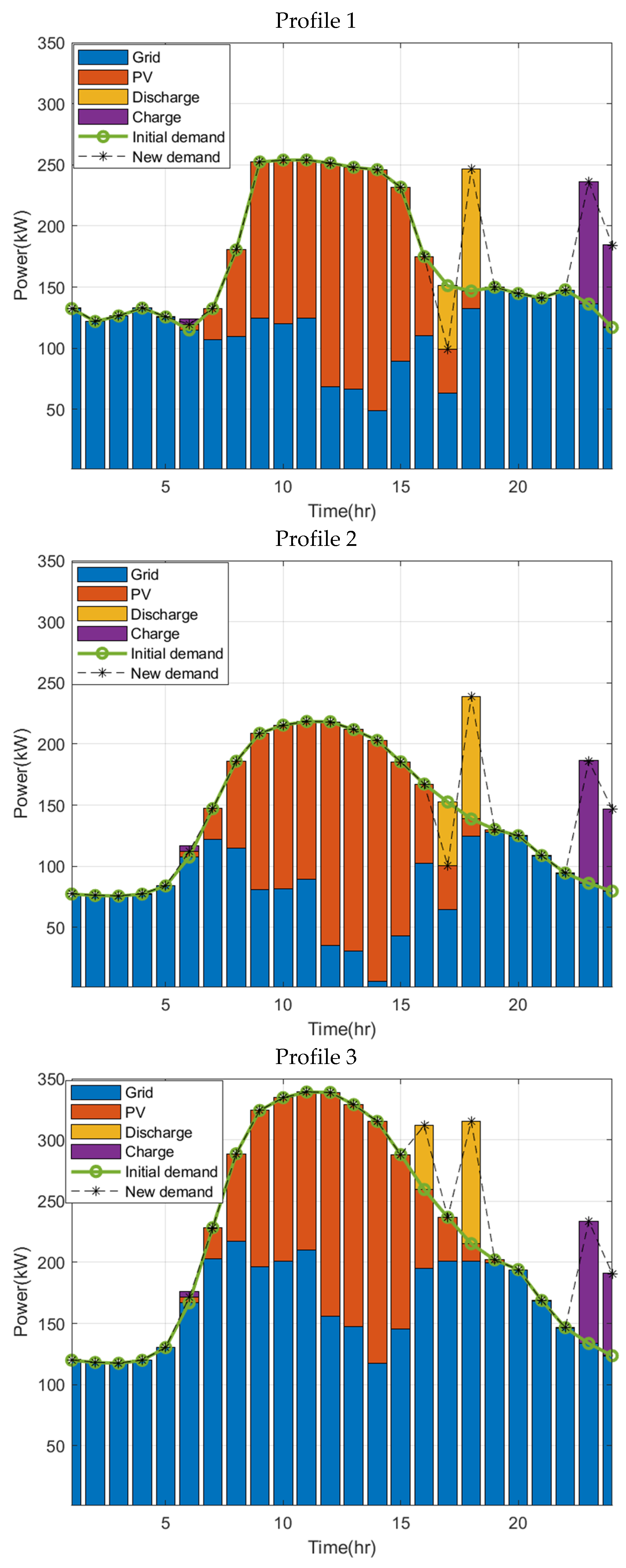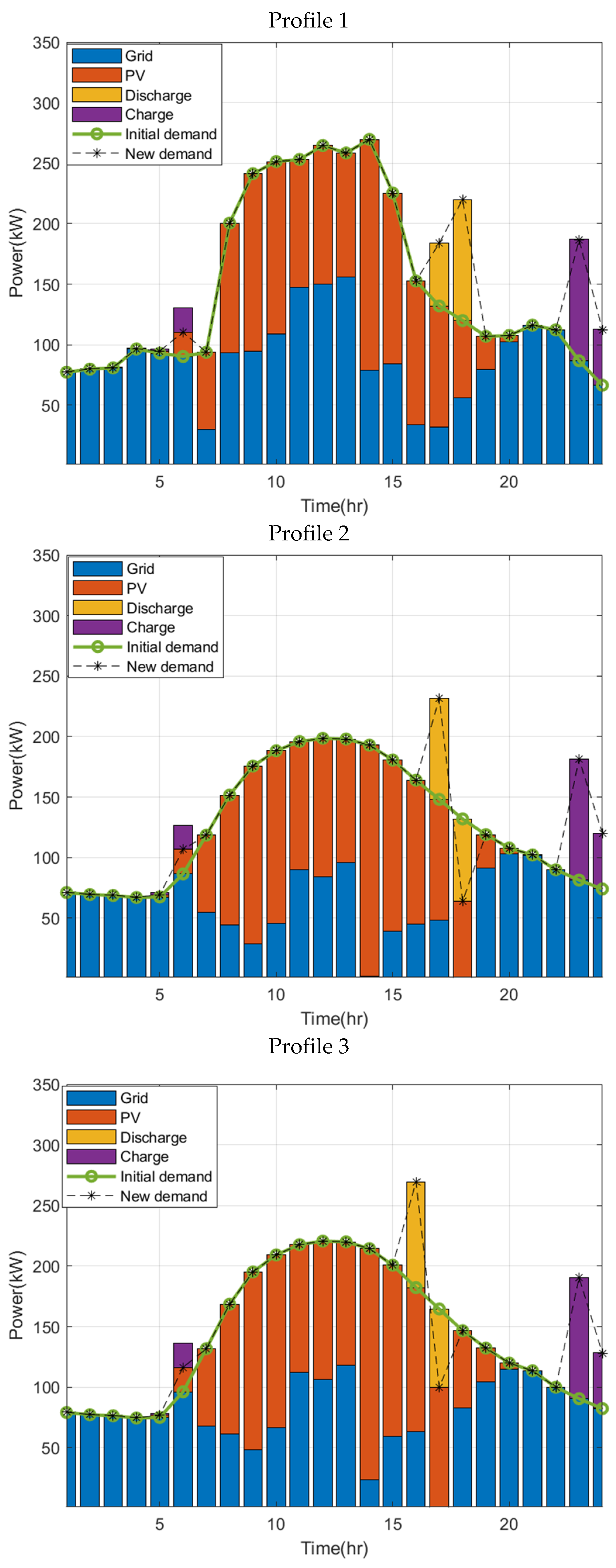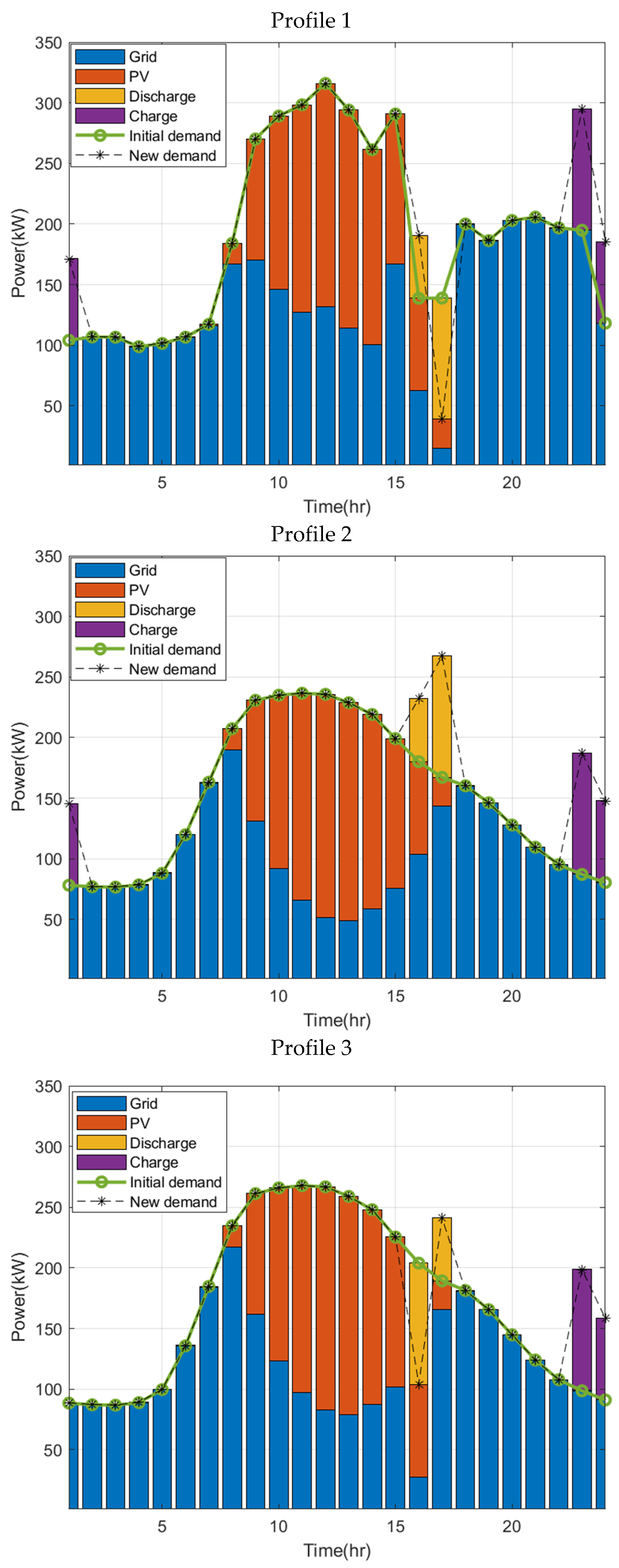The increase in energy costs and the need to decarbonize the energy market prompt the search for functional and organizational alternatives and mechanisms [
1,
2]. Desirable solutions include the promotion of greater activation and participation of energy recipients as part of new prosumer models and autonomous civic energy communities [
3], including in particular households in multifamily buildings, entrepreneurs from the small and medium enterprises (SME) sector, and local governments, and their joint participation in planning local renewable energy sources, energy storage, and infrastructure networks [
4].
It is also important to increase the role of electricity storage [
5], as well as gas, heat, and cold [
6], for optimal use of surplus energy from renewable energy sources (RESs) that consumes the dynamic increase in installed capacity in this sector and to improve the stability of energy networks [
7]. In the last decade, there has been great interest among consumers (both individual and industrial) in the use of energy storage systems for cooperation with the power grid. Their purpose is not only to reduce the cost of energy consumption, but also from the point of view of industrial customers, to ensure the security of production continuity by protecting the operation of sensitive equipment against the lack of energy supply during technological processes [
8]. The importance of energy storage systems (ESSs) is also demonstrated by the interest of the scientific world [
9]. Scientific works are focused on areas such as the technology of ESS implementation, issues related to planning and optimization of system operation with different load profiles, and consequently proposals of optimization tools application, as well as issues of its operation with the power system and renewable energy sources [
10,
11].
The application of an ESS to microgrid (MG) issues with a comprehensive review was presented in Ref. [
12]. The article considers control approaches, challenges, solutions, applications, and overall management prospects. The author pointed out that MG integration may assure some benefits. There is a need for this to face many challenges and issues in its control and management, which can be effectively dealt with by incorporating ESS technologies into MGs (the block diagram representation of various applications of an ESS and the energy management system (EMS) strategies for the MG application are presented). From an economic point of view, future trends and real-time applications are also clarified, greatly contributing to the development of a cost-effective and robust longer-life ESS architecture for renewable MG applications [
13].
The considerations presented above on the proper and effective cooperation of an ESS with the power system are united by one main denominator: the use of appropriate load profiles, which depend on the actual variable nature of operation of the industrial consumer’s equipment. This paper discusses the performance of an integrated ESS with a PV system and an industrial consumer. The novelty is that the paper presents the concept of implementing different real load profiles into the operation of an energy storage system (ESS). It must be noted that considered approaches are based on real long-term measurements using energy meters. Cases for real and pseudo-real load profiles are discussed.
1.1. Literature State of the Art
The use of RESs due to randomness and intermittence generation usually leads to excessive system size. This phenomenon causes the increase in the system capital cost. [
17] Therefore, hybrid renewable energy systems (HRESs), systems that consist of an RES and ESS together, have been proposed to address these problems. It is essential to optimize the operation of an HRES to utilize an RES in technical as well as economic aspects. Several types of research related to microgrid control have been conducted in the past years, where the short-term load forecasting (STLF) plays an increasing role. Accurate forecasting of the electrical load has become the top management objective, but the electrical load often presents nonlinear data patterns. The effective forecasting of forthcoming electricity demand is hard due to the complex effects of various factors. Thus, a rigid forecasting approach with strong capabilities for general nonlinear mapping is necessary.
A large group of short-term load forecasting methods use artificial neural networks (ANN) associated with deep learning techniques (DL). The paper [
18] proposed the use of a long-term memory-based recurrent neural network (LSTM) for short-term load forecasting for individual households. It is one of the latest and popular deep learning techniques. This is a basic load forecasting approach. The proposed ANN structure was tested on residential smart meter data, and its performance was compared with various methods including state-of-the-art load forecasting. The results showed that the proposed LSTM approach outperforms other algorithms mentioned in the paper. The authors in [
19] suggested a deep convolutional neural network based on residual neural network (ResNet) to forecast the building load one hour in advance. Additionally, a branch was designed to integrate the hourly temperature with the forecasting branch. To enhance the learning ability of the HRES model, an innovative feature fusion was presented. Finally, studies on point forecasting, probabilistic forecasting, fusion method, and computational performance were conducted. The results showed that the proposed model has high performance, which reflects a promising prospect in the application. The work performed in [
20] studied the temporary behavior of a series over a period of a month of electricity demand in Spain, achieved by subtracting the trend from the series of consumption. A new hybrid solution was suggested that considers the periodic behavior to be predicted by means of a Fourier series, while the trend was predicted by means of a neural network. Satisfactory results were obtained, which improved those obtained when only neural networks or autoregressive integrated moving average (ARIMA) were used for the same purpose. The new method for daily load forecasting based on wavelet neural network was presented in the paper [
21]. The method is based on selecting a typical daily load as the input load. Based on correlation and using wavelet decomposition and separate neural networks, the load characteristics for low-frequency and high-frequency components were selected. The high-frequency components were well predicted by considering weather conditions and the high-frequency component of the typical daily load as input data. The test results showed that this method makes accurate predictions. An interesting approach shown in [
22] is the prediction of short-term residential loads using a graph-based neural network. This method used not only historical load data, but also implicit spatial dependencies of neighboring houses. By introducing similar energy consumption patterns due to common weather and social conditions, machine-learning-based forecasting methods can significantly improve the forecasting accuracy compared to basic models. The short-term load forecasting method with the empirical-mode decomposition algorithm (EMD) was proposed in [
23]. The load was decomposed into frequency components varying from the low to high levels. The periodic low-frequency components were predicted by the multivariable linear regression method (MLR), while the high-frequency components were forecasted by the LSTM neural network algorithms. The load behavior was obtained by combining two methods. The proposed method was validated by experiments. The prediction of the load behavior was accurate globally along with the local details, which verified the effectiveness of the presented method.
Algorithms using support vector regression (SVR) and optimization methods such as artificial neural network (ANN), genetic algorithm (GA), or particle swarm optimization (PSO) are a separate group. The hybrid method based on the support vector regression considering meteorological factors and the price of electricity was indicated in [
24]. The data used in this paper were combinations of values of individual characteristic parameters affecting electricity load, which are analyzed in hour resolution. Then, SVR was applied to analyze and develop the load forecasting model. Finally, the improved adaptive genetic algorithm was used for optimizing the combination of the ratio values of each characteristic parameter. Experimental results showed that the proposed method can obtain better prediction performance compared with other standard and state-of-the-art methods. The purpose of the paper [
25] was to consider an SVR model with an immune algorithm (IA), named SVRIA, for electrical load prediction. IA was used for determination of the parameters of the SVR model. Empirical results showed that the SVRIA model gives better forecasting results than the other methods, namely support vector machine with genetic algorithm (SVMG), regression model, and ANN model. Electricity demand forecasting was indicated as a useful tool for network maintenance planning and market research of power companies. The approaches took into account weather and economic variables that significantly affect electricity demand. Economic variables usually affect the overall trend of the series, while weather provides periodic behavior due to its seasonal nature. The paper [
26] proposed a new approach for accurate STLF utilizing a support vector regression (SVR) and optimization method. The SVR model was trained by the load data. For better performance of the model, a two-step optimization algorithm was proposed to determine the best parameters. In the first step, a designed grid traverse algorithm (GTA) was used to narrow the parameter searching area from a global to local space. In the second step, PSO was used to determine the best parameters. The performance of the proposed approach is compared to some classic methods of that paper. The work [
27] presented a basic strategy for STLF based on the SVR. Two important improvements to the proposed SVR model were introduced: procedures for the generation of SVR model inputs and model input selection using feature selection algorithms. One of the objectives of the proposed strategy is to reduce the operator interaction in the model-building process. The proposed use of feature selection algorithms for automatic model input selection and the use of the PSO-based technique for the optimization of SVR parameters were proposed. To confirm the effectiveness of the proposed method, the model was trained and tested on well-known load forecasting data sets and compared to the state-of-the-art STLF. The article [
28] presented a solution for forecasting the demand for electric energy in a month period. The solution was based on a support vector machine. The SVM approximated the association between historical and forthcoming demand patterns. It also considered energy demand time-series exhibit instability, as well as seasonal fluctuation cycles, long-term trends, and random noise. To make the forecasting problem simpler, the demand time-series in the one-month period were represented by annual cycle patterns that unify data and remove trends. The coding variables were determined using historical or forecast data using ARIMA statistical methods and exponential smoothing. In comparison to the other models the obtained outcomes assured the high performance and competitiveness of the considered model.
Very effective methods for short-term load prediction were deep learning techniques using historical measurement data and other conditions that affect the correctness and accuracy of the prediction. The work of [
29] aimed to show recent breakthroughs in deep learning, while using the structure of the problem to develop effective prediction tools. The proposed method provided information about intervals and prediction density, but here it is extended to include the goal of generating prediction scenarios. The effectiveness of the proposed methodology was highlighted and compared with several other architectures in terms of statistical results and impact on the quality of decisions optimized in a dedicated stochastic optimization tool for an electricity retailer participating in short-term electricity markets. The paper [
30] showed a new holographic ensemble forecasting method (HEFM). It used mutual information and a statistical model to select characteristic variables. It generated training data using bootstrap functions. A model was constructed using various artificial intelligence and machine learning algorithms. The method used the original load forecast features, which were the result of multiple heterogeneous models trained in the initial learning process, and actual load measurements from the last period before each forecast. This paper compared the results with state-of-the-art forecasting methods. In the article [
31], the Bayesian deep learning technique was used to solve demand forecasting problems. Specifically, a novel multi-objective framework based on deep Bayesian learning was proposed to quantify common uncertainties between customer groups considering their differences. Furthermore, a clustering-based data fusion method was prepared to increase the diversity and volume of data. This not only solves the problem of excessive data volume but also improves predictive performance. Presented numerical results showed that the proposed method provides higher probabilistic prediction accuracy than conventional methods. The paper [
32] proposed a short-term individual housing load forecasting method based on a combination of deep learning and k-means clustering, which was able to effectively extract load similarity and accurately forecast housing load at the individual level. It first makes full application of the k-means clustering to extract the similarity between housing loads, and then applies deep learning to extract the complex patterns of housing loads. The presented method was tested and validated on a real load data set, and experimental results suggest that it can achieve significantly higher prediction accuracy compared to published other methods.
The remaining group of methods are algorithms that use various statistical models for short-term load forecasting in distribution networks. Their effectiveness was confirmed in publications. The paper [
33] proposed a novel and easy-to-implement approach for combining probabilistic load forecasts to improve the performance of the forecasting. The combination problem was defined as the optimization problem. It was conducted by searching the weights of each individual method. Under the assumption of Gaussian distribution for density forecasts, this problem was transformed into a linearly constrained quadratic programming problem. Density forecasts may provide additional information considering the uncertainty that can be expressed by quantiles and intervals. Case studies on the electrical load data set of lot of localizations verify the effectiveness of the proposed method. In the paper [
34], a new functional time-series methodology for short-term load forecasting was introduced. The prediction was performed using weighted average of historical daily load segments, the shape of which was similar to the expected shape of the load segment to be predicted. The past load segments were identified from the available history of the observed load segments by means of their closeness to the reference segment. The better segment is selected in a manner that captures the expected qualitative and quantitative characteristics of the load segment to be predicted. As an illustration, the suggested functional time-series forecasting methodology was applied to historical daily load data. Its performance was compared with some recently proposed alternative methodologies for STLF.
As shown in selected publications in this section, describing the current state of research of short-term load prediction is mainly for a period of one day and is usually generated with a resolution of one hour. Most of the proposed methods use measured historical load data and more or less complicated mathematical algorithms. However, there is a lack of methods that estimate the efficiency of a microgrid for which measurements are not yet available, for example at the stage of grid design and dimensioning of its components such as PVs and an ESS.
1.2. Motivation, Contribution, and Organization of the Article
With the increasing number of PVs for industry applications, the number of storage applications is also increasing to meet local demands. In the majority of cases, the planning of the ESS is based on the financial investment possibilities of the companies. Thus, in many cases, there is a need to define only the correct operation for the ESS system of the companies with the PV system. However, the basic issue in operation is to ensure the real energy demands that should be covered. In the major cases, only one-month consumption is given by the energy metering system. Thus, there is a need to define additional, as close as possible to real profiles for the companies, especially in the long-term horizon, which considers both day-horizon (hours resolution) as well as session changes (months horizon).
In this article the defining long-term load profile in the case of a lack of real measurements is discussed. The applied methods are based on energy consumption level based on electric bills, standard profile, and short-term (1 week) measurements. Additionally, for the investigated company the real load profiles are available. Thus, the comparison for one-year data was possible. Then, the operation for a microgrid consisting of grid, a 317 kW PV system, and a 200 kW ESS to cover previously defined load profiles in a one-year period is presented and compared. To summarize the main contribution of the paper, it proposes different ways to obtain “as real as possible” load profiles to assure optimal operation of the ESS, in case of a lack of real profiles of which planning issues were solved before. It is worth noting that the novel approach enables to define a satisfactory long-term profile using only short-term measurements and freely accessible data, without the costly and time-consuming actions.
Section 2 introduces the methodology to define differently the load profiles of the industrial customer and ESS operations.
Section 3 contains the description of the investigated company and energy cost in Poland.
Section 4 presents the results of defining different profiles and the operation of an ESS under them.
Section 5 concludes the paper.
